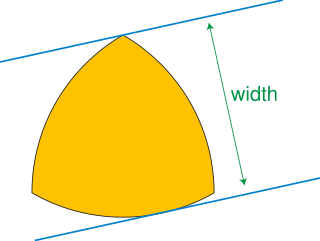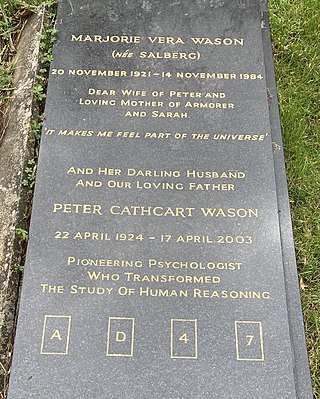
In geometry, a diameter of a circle is any straight line segment that passes through the centre of the circle and whose endpoints lie on the circle. It can also be defined as the longest chord of the circle. Both definitions are also valid for the diameter of a sphere.

Euclidean geometry is a mathematical system attributed to ancient Greek mathematician Euclid, which he described in his textbook on geometry, Elements. Euclid's approach consists in assuming a small set of intuitively appealing axioms (postulates) and deducing many other propositions (theorems) from these. Although many of Euclid's results had been stated earlier, Euclid was the first to organize these propositions into a logical system in which each result is proved from axioms and previously proved theorems.
In the philosophy of mind, functionalism is the thesis that each and every mental state is constituted solely by its functional role, which means its causal relation to other mental states, sensory inputs, and behavioral outputs. Functionalism developed largely as an alternative to the identity theory of mind and behaviorism.

In four-dimensional geometry, the 24-cell is the convex regular 4-polytope (four-dimensional analogue of a Platonic solid) with Schläfli symbol {3,4,3}. It is also called C24, or the icositetrachoron, octaplex (short for "octahedral complex"), icosatetrahedroid, octacube, hyper-diamond or polyoctahedron, being constructed of octahedral cells.

A wallpaper is a mathematical object covering a whole Euclidean plane by repeating a motif indefinitely, in manner that certain isometries keep the drawing unchanged. For each wallpaper there corresponds a group of congruent transformations, with function composition as the group operation. Thus, a wallpaper group is a mathematical classification of a two‑dimensional repetitive pattern, based on the symmetries in the pattern. Such patterns occur frequently in architecture and decorative art, especially in textiles, tessellations, tiles and physical wallpaper.

In geometry, a curve of constant width is a simple closed curve in the plane whose width is the same in all directions. The shape bounded by a curve of constant width is a body of constant width or an orbiform, the name given to these shapes by Leonhard Euler. Standard examples are the circle and the Reuleaux triangle. These curves can also be constructed using circular arcs centered at crossings of an arrangement of lines, as the involutes of certain curves, or by intersecting circles centered on a partial curve.
The Bertrand paradox is a problem within the classical interpretation of probability theory. Joseph Bertrand introduced it in his work Calcul des probabilités (1889) as an example to show that the principle of indifference may not produce definite, well-defined results for probabilities if it is applied uncritically when the domain of possibilities is infinite.

In geometry and crystallography, a Bravais lattice, named after Auguste Bravais, is an infinite array of discrete points generated by a set of discrete translation operations described in three dimensional space by

Life and death (死活) is a fundamental concept in the game of Go, where the status of a specific group of stones is determined as either being "alive", where they may remain on the board indefinitely, or "dead", where the group will be "captured" and removed from the board. The basic idea can be summarized by:
A group must have a means to evade capture -- forever -- by having at least two liberties that can't be filled at the same time to sustain itself.
A philosophical zombie is a being in a thought experiment in philosophy of mind that is physically identical to a normal human being but does not have conscious experience.

The Wason selection task is a logic puzzle devised by Peter Cathcart Wason in 1966. It is one of the most famous tasks in the study of deductive reasoning. An example of the puzzle is:
You are shown a set of four cards placed on a table, each of which has a number on one side and a color on the other. The visible faces of the cards show 3, 8, blue and red. Which card(s) must you turn over in order to test that if a card shows an even number on one face, then its opposite face is blue?
De Interpretatione or On Interpretation is the second text from Aristotle's Organon and is among the earliest surviving philosophical works in the Western tradition to deal with the relationship between language and logic in a comprehensive, explicit, and formal way. The work is usually known by its Latin title.

Wheeler's delayed-choice experiment describes a family of thought experiments in quantum physics proposed by John Archibald Wheeler, with the most prominent among them appearing in 1978 and 1984. These experiments are attempts to decide whether light somehow "senses" the experimental apparatus in the double-slit experiment it travels through, adjusting its behavior to fit by assuming an appropriate determinate state, or whether light remains in an indeterminate state, exhibiting both wave-like and particle-like behavior until measured.

Peter Cathcart Wason was a cognitive psychologist at University College, London, who pioneered the psychology of reasoning. He sought to explain why people consistently commit logical errors. He designed problems and tests to demonstrate these behaviours, such as the Wason selection task, the THOG problem and the 2-4-6 problem. He also coined the term "confirmation bias" to describe the tendency for people to immediately favor information that validates their preconceptions, hypotheses and personal beliefs regardless of whether they are true or not.

Future contingent propositions are statements about states of affairs in the future that are contingent: neither necessarily true nor necessarily false.
In mathematics education, the Van Hiele model is a theory that describes how students learn geometry. The theory originated in 1957 in the doctoral dissertations of Dina van Hiele-Geldof and Pierre van Hiele at Utrecht University, in the Netherlands. The Soviets did research on the theory in the 1960s and integrated their findings into their curricula. American researchers did several large studies on the van Hiele theory in the late 1970s and early 1980s, concluding that students' low van Hiele levels made it difficult to succeed in proof-oriented geometry courses and advising better preparation at earlier grade levels. Pierre van Hiele published Structure and Insight in 1986, further describing his theory. The model has greatly influenced geometry curricula throughout the world through emphasis on analyzing properties and classification of shapes at early grade levels. In the United States, the theory has influenced the geometry strand of the Standards published by the National Council of Teachers of Mathematics and the Common Core Standards.
In mathematics, an orthogonal array is a "table" (array) whose entries come from a fixed finite set of symbols, arranged in such a way that there is an integer t so that for every selection of t columns of the table, all ordered t-tuples of the symbols, formed by taking the entries in each row restricted to these columns, appear the same number of times. The number t is called the strength of the orthogonal array. Here are two examples:

In philosophy of mind, qualia are defined as instances of subjective, conscious experience. The term qualia derives from the Latin neuter plural form (qualia) of the Latin adjective quālis meaning "of what sort" or "of what kind" in relation to a specific instance, such as "what it is like to taste a specific apple — this particular apple now".
In mathematics and computer science, the method of conditional probabilities is a systematic method for converting non-constructive probabilistic existence proofs into efficient deterministic algorithms that explicitly construct the desired object.
In mathematics and mathematical logic, Boolean algebra is a branch of algebra. It differs from elementary algebra in two ways. First, the values of the variables are the truth values true and false, usually denoted 1 and 0, whereas in elementary algebra the values of the variables are numbers. Second, Boolean algebra uses logical operators such as conjunction (and) denoted as ∧, disjunction (or) denoted as ∨, and the negation (not) denoted as ¬. Elementary algebra, on the other hand, uses arithmetic operators such as addition, multiplication, subtraction, and division. Boolean algebra is therefore a formal way of describing logical operations, in the same way that elementary algebra describes numerical operations.












